Emilene Leone explains the step-by-step process to creating her “home gone wild in suburbia,” with phenomenal photographs of the flowers, birds, and insects that visit her native plant garden in Davenport. -promoted by Laura Belin
For the last two summers, I have been working on converting large sections of my home’s yard to native plant space. I’ve been documenting the process both on my own Facebook page, as well as on Casa Leone Gardens. I was invited to write a post about my project for Bleeding Heartland’s wonderful “Wildflower Wednesday” series, and I’m so happy to do so!
My family purchased our home in Davenport, Iowa about five years ago. It’s in a sort of standard 1990s cul-de-sac type of area, very much a suburban sort of neighborhood with neat and tidy landscaping, and homes with great expanses of manicured lawns. When we bought our home, the landscaping consisted of standard sort of builder-basic landscaping shrubs, surrounded by seas of mulch.
To me, yardwork was a necessary evil. Mowing has never been a favorite pasttime for us, and maintaining the mulch beds seemed like a non-stop battle, an annual chore of applying more and more and more mulch, only to see weeds pop up anyway—mostly thistle, dandelions and black medic, with some invasive vines mixed in as well. At first, I did use chemicals to try to control the weeds, but as I learned more about them, I decided I didn’t want to use chemicals. Very quickly, the mulch beds went from neat and tidy to a complete mess.
My first attempt to plant a native garden came from complete laziness on my part. I decided to buy a wildflower seed mix at the garden store, spread it over the beds, and hope for the best.
To my utter surprise, the seeds actually started to grow and thrive! I don’t think I have a photo of them from last year, but here’s what those thistle-filled weedy mulch beds look like this year:
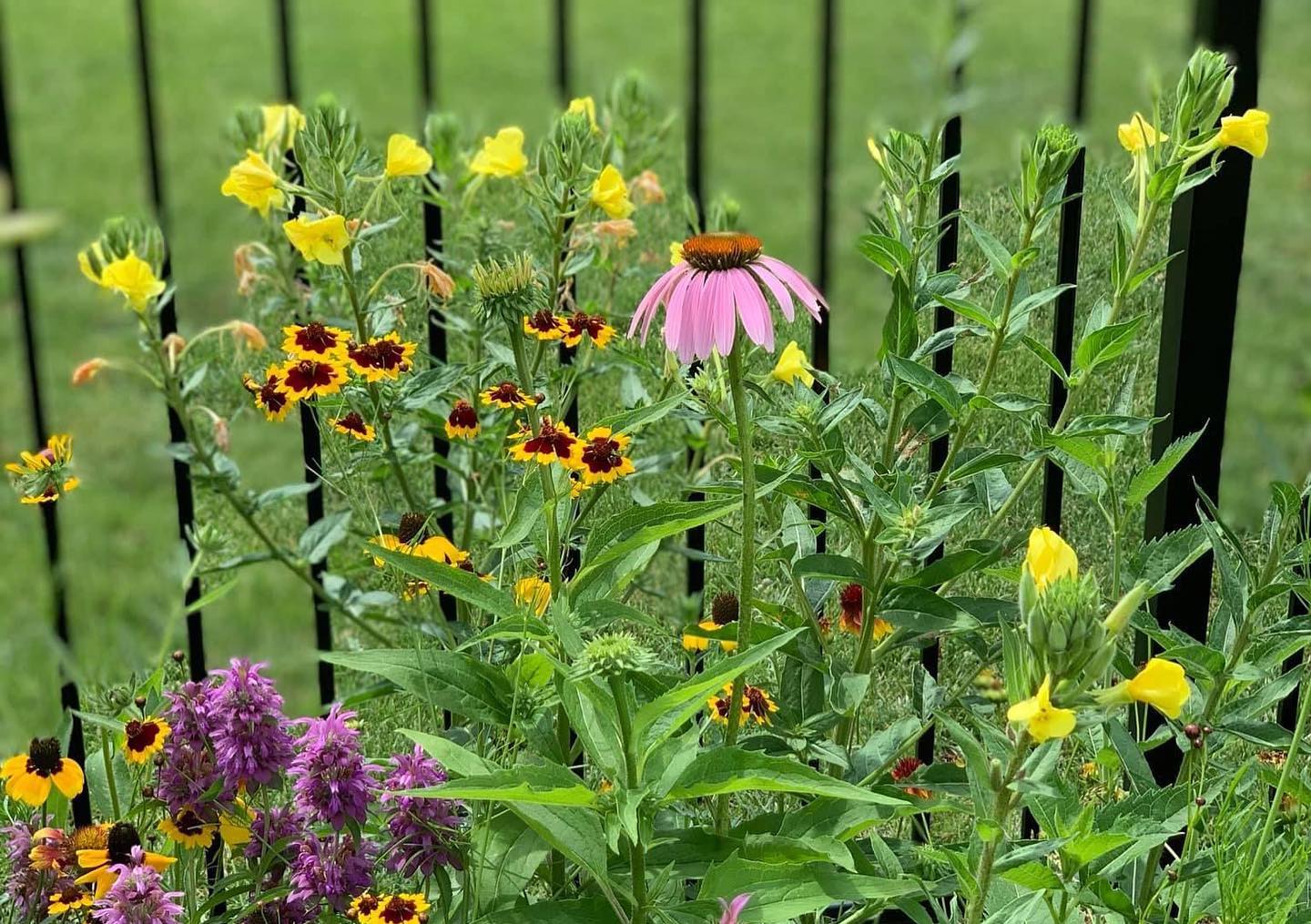
Mix including purple coneflower, common evening primrose, and plains coreopsis
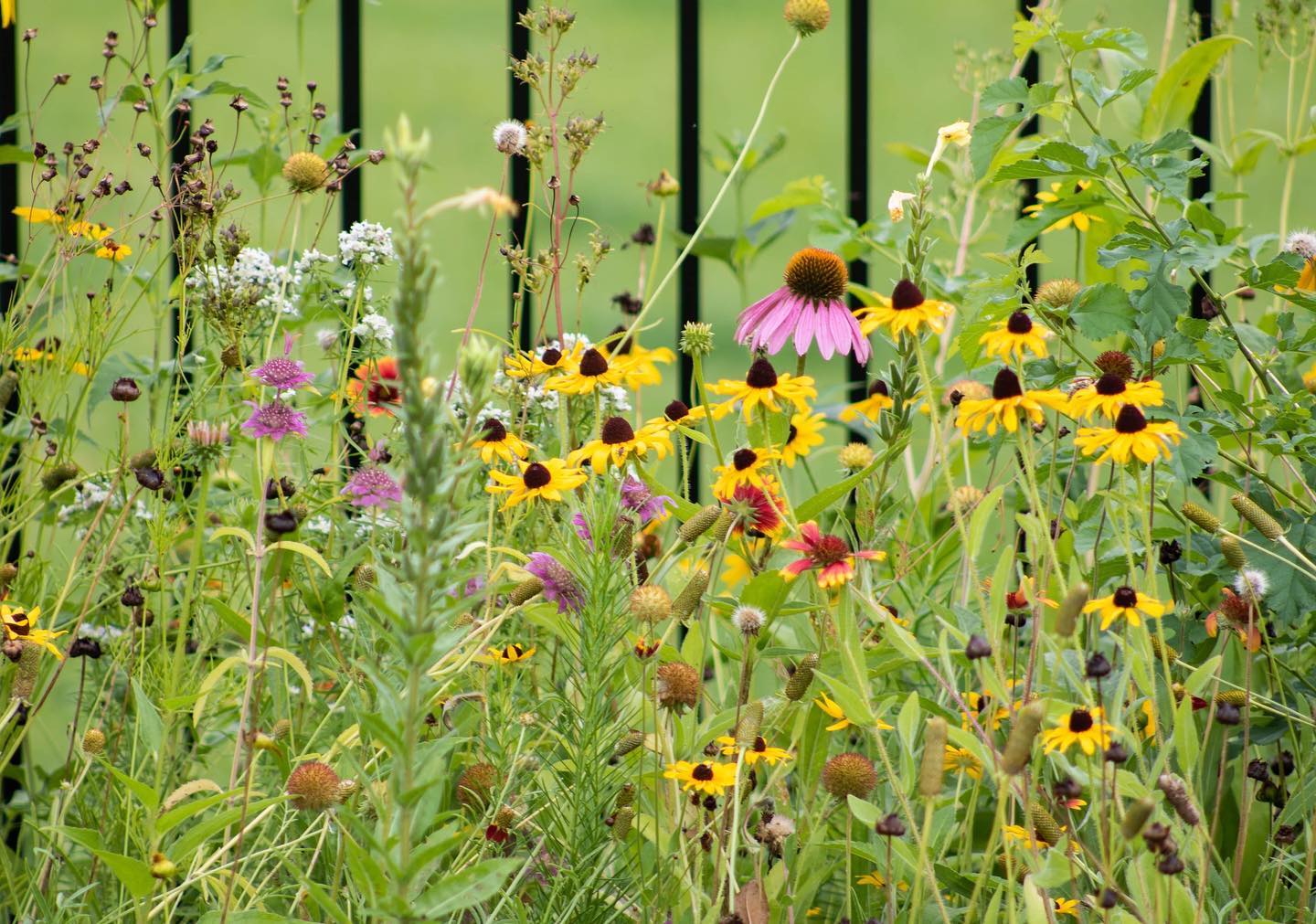
Mix including Black-eyed Susan, purple coneflower, and mountain mint
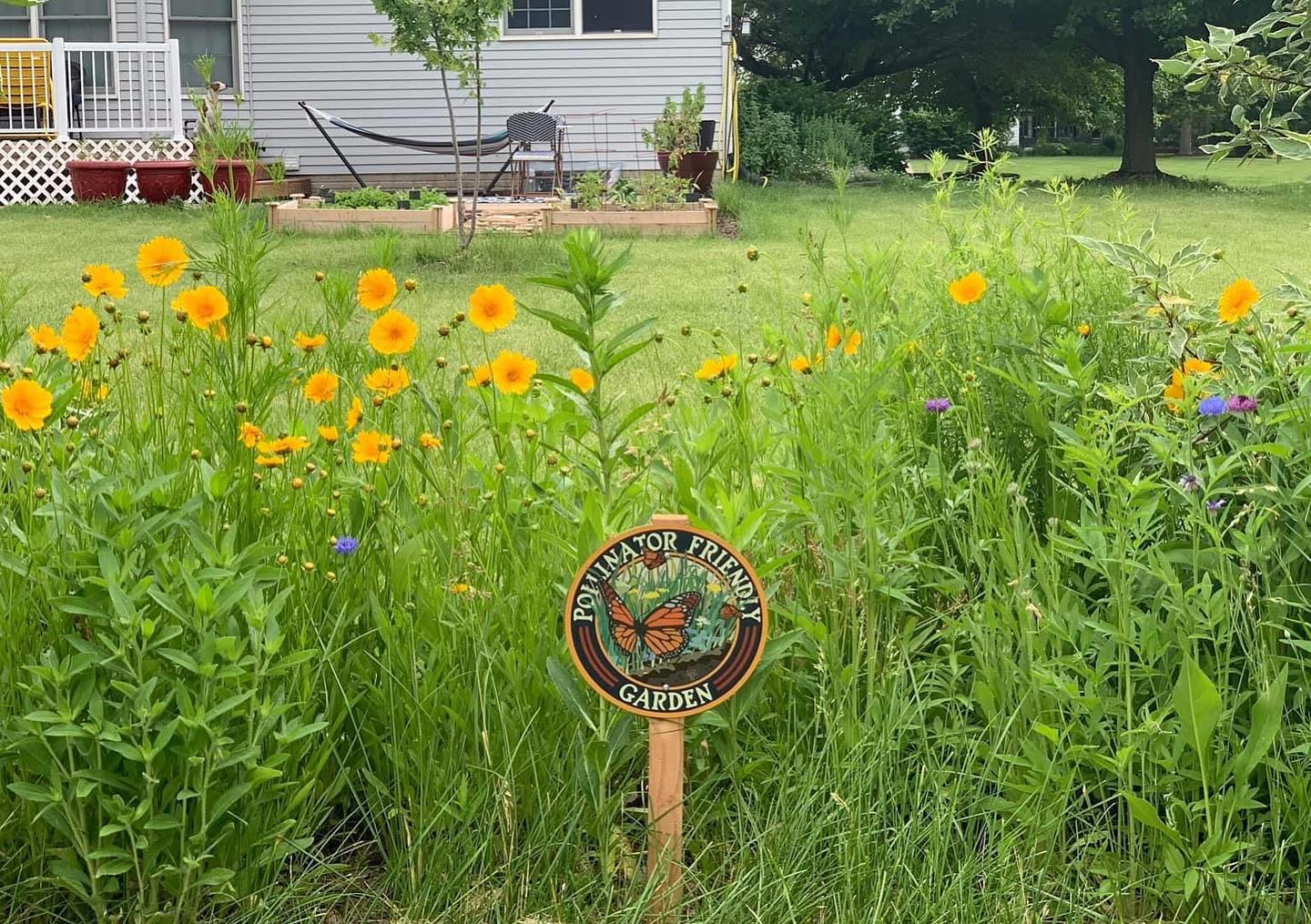
Mix including lanceleaf coreopsis, also known as sand coreopsis
Once I saw how beautiful these flowerbeds were becoming, I started reading quite a bit about the benefits of native plant gardening, and from there, an obsession was born.
“Native plant” is a term that refers to plants that grew and developed in an area naturally, prior to settlers from Europe coming to the Americas and changing the landscape. While those of us in Iowa might think of the red clover, Queen Anne’s Lace and Tiger Lillies we see in our country road ditches as Iowa’s wildflowers, those are all species from other continents, introduced to the area as settlers started farming the land. There are thousands of varieties of native plants, but some of the ones most people are familiar with include Black-Eyed Susans, Coneflowers, and varieties of Milkweed. Bleeding Heartland is a fantastic source for learning about Iowa’s native plants.
The more I learned about native plants, the more I thought they might be a good fit for me. Native plants, once established, really sort of know how to take care of themselves. Being indigenous to our climate, they don’t generally require any sort of regular watering or chemicals. They spread–some more than others–when given the space to do so and will quickly fill in to become lush and colorful. Environmentally speaking, they help retain water in the land because of their deep roots, and they lessen the wastewater that makes it to our sewers, creeks and rivers, especially important in Davenport because we are prone to flooding.
Native plants are incredibly crucial to our local bird, bee and insect populations as well. Many types of caterpillars can only eat specific leaves of specific plants. Without those plants, we will have no caterpillars and without those caterpillars, we will have no butterflies. Caterpillars make up a big part of the diet of baby birds, so if we don’t have caterpillars, bird populations suffer as well.
After learning of some of the benefits, I decided to take on the project of adding some more native plant beds to my yard. I decided to start in my front yard, which is a bit of an unusual choice because in my neighborhood, most front yards are very grass-focused…large expanses of green, with maybe a few shrubs or lilies thrown in here and there. I decided to start on my front yard mainly because I see it more than I see my backyard. I wanted to see a sea of beautiful flowers when I pulled into my driveway, or while sitting near my living room and bedroom picture windows.
First step: killing off the grass. You do need to remove grass before planting native seeds to give the seeds a chance to establish, so they don’t have to battle grass as they grow. Not wanting to use any sort of chemical, I decided to use the “lasagna method”, or sheet mulching of layering cardboard, then mulch over the grass to essentially smother it.
I usually go to the dumpsters behind the nearest strip mall to get as many boxes as I could possibly want. The bigger the better, since you want to minimize spaces where weeds can (and will!) creep through. The worst part of that process is honestly removing all the tape. Tape will not disintegrate, so make sure to remove it before putting the cardboard down.
After a few weeks of hot summer sun, the grass underneath begins to brown. After a few months, it’s dead. Within a year, the cardboard disintegrates, adding its organic matter to your soil. And then you’re ready to plant seeds!
While the grass is cooking away underneath the cardboard and mulch, it at least looks presentable, if boring. Conveniently for me, large expanses of mulch with no plants inside it is a pretty standard sight in my neighborhood. I created a few beds in my front yard last year.
While on the topic of grass, let me take a few moments to rant about the history of grass. It seems like kind of a weird topic to feel strongly about, but I’ve become quite the anti-grass evangelist lately, so indulge me if you would. You can read a lot about the topic online (there is quite an anti-lawn movement starting), but the short version is that most grass we see in lawns is an invasive species introduced to America when European royalty started planting large grass lawns, basically to show off how rich and successful they were because a) they didn’t need the land for growing food, and b) they had either servants or enslaved labor to care for it. Wealthy Americans wanted to emulate the trappings of European landowner wealth, so they started growing lawns to imitate them. It’s essentially a leftover remnant of colonialism.
Additionally, grass doesn’t really want to grow here. Unless you commit to chemicals, fertilizers, pesticides, sprinkler systems, watering, and pretty much constant babying, you won’t have that “perfect” suburban dream of a meticulously green and lush lawn. Maybe it’s time to give up that dream? In my opinion, the pursuit of a perfect green lawn still has some aspects of classism to it, a way to show wealth, to “flex” and brag that one has the time and money to devote to maintaining a spotless green lawn.
I’ve never really cared about keeping up with the Jones’, personally. Here’s what my grass looked like before:
Patchy, dry, ugly, absolutely lifeless.
Here’s the same spot now:
I encouraged the clover to sort of take over, a death match: clover versus the nastier weeds. The clover, although not a native plant, does at least have some advantages over turf grass. It stays green even during the the driest spells, it doesn’t have to be mowed as often, and honeybees enjoy the blooms.
Around this time, I learned about a fantastic program that the City of Davenport offers to support homeowners in creating native gardens. It’s called “Native Roots”. To be a part of the program, a homeowner submits an application and their garden plans. The plans and site are inspected and if approved, the city provides a sign to post in your yard to let your neighbors know that you are planting a city-approved native garden.
Native plants can be tall and sometimes weedy looking, depending on the time of their growth cycle. Having a sign lets neighbors know there is sort of a method to your madness, and you haven’t just let your yard become a complete weed-patch. If a concerned neighbor does call to report your yard for violating weed ordinances, the sign also lets city employees know that the plants are not weeds.
I planted some plants in the beds by fall, and in the spring, I spread a native Midwestern seed mix throughout the yard. I also purchased some native plant through Rock Island County Soil and Water Conservation District and the “Friends of Hauberg” native plant sale. Prairie Moon Nursery has also been a great source, since they specialize in native plants.
It can be a little tricky to find native plants at garden centers, either due to a lack of variety, or a lack of knowledge by employees. Many times they sell cultivated plants as native plants erroneously, and they just aren’t the same. Best to go to a source that is specifically focused on native plants.
Coronavirus quarantine gave me lots of time to play around in my yard, and watch the progress. Every day, different blooms seemed to appear, absolutely delighting and surprising me. Watching my yard come to life has been such a blessing and much-needed mental escape during this stressful time.
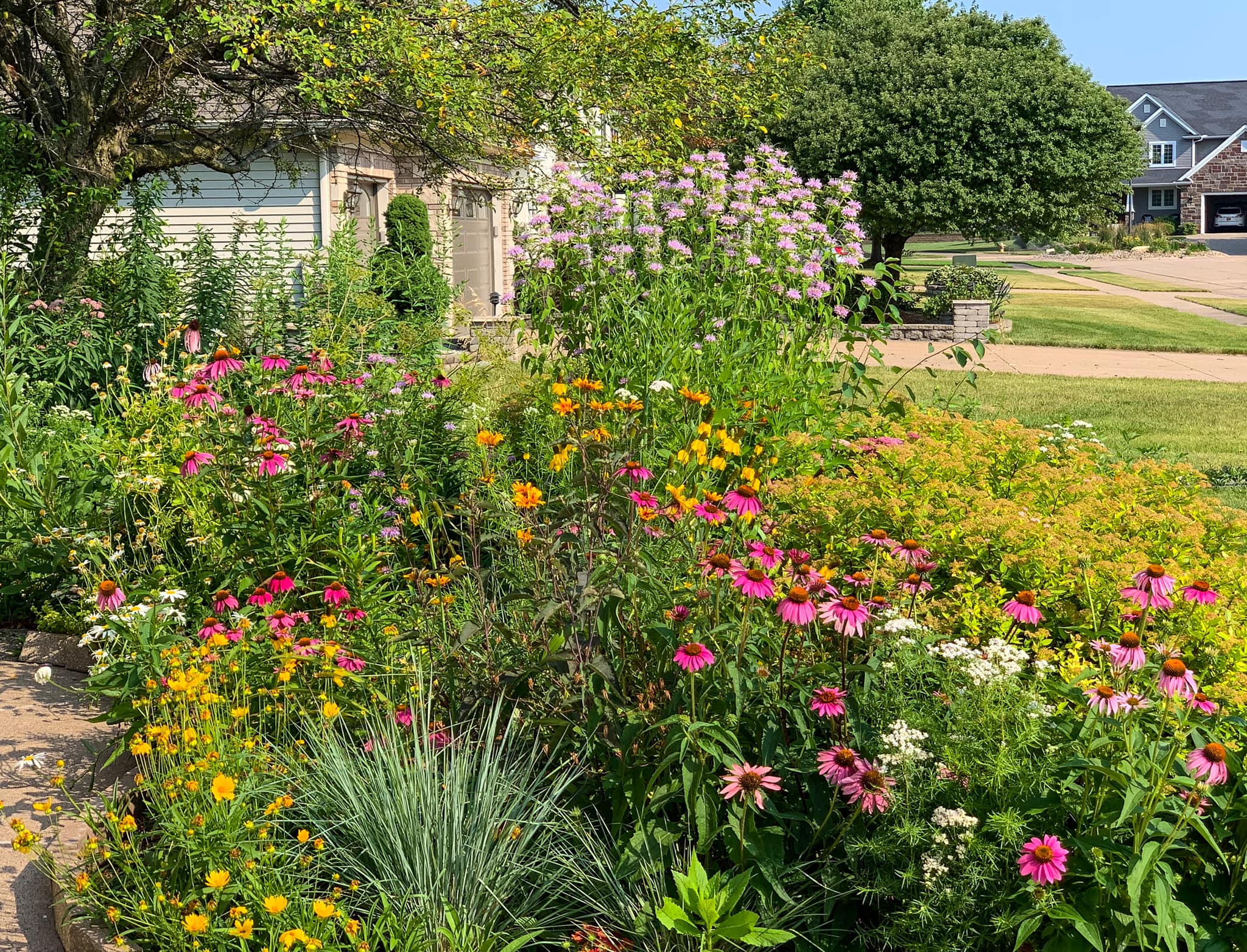
Mix including sand coreopsis, purple coneflower, and wild bergamot (also known as bee balm or horsemint), and mountain mint
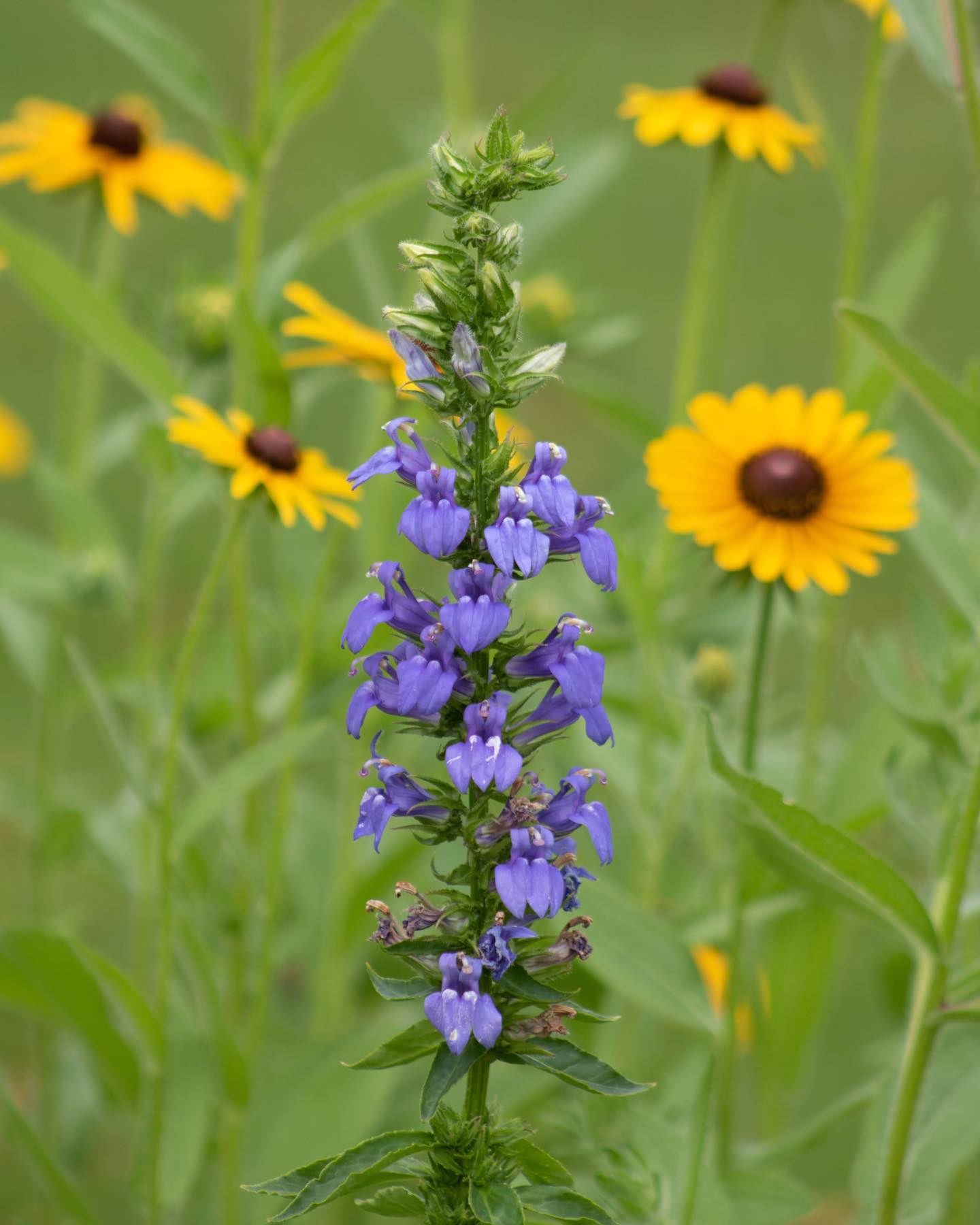
Great blue lobelia with black-eyed Susans or possibly sweet coneflowers in background
It has been incredible to see the amount of wildlife that has found my gardens. Wherever I look, there are birds, bees, and butterflies to watch and enjoy. As a photographer, it is delightful to sit and watch and capture images as I see my little visitors fly around, visiting different blooms.
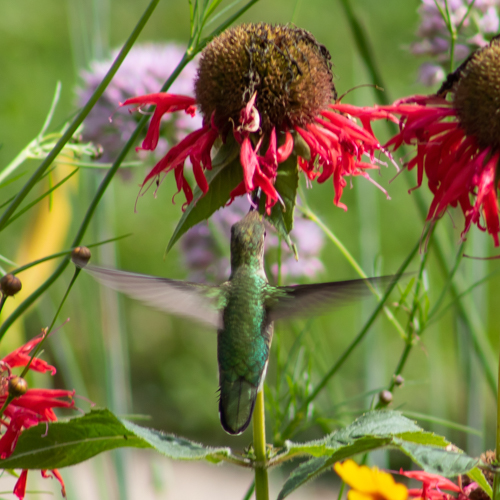
Hummingbird sampling oswego tea, also known as red bergamot or scarlet bee balm
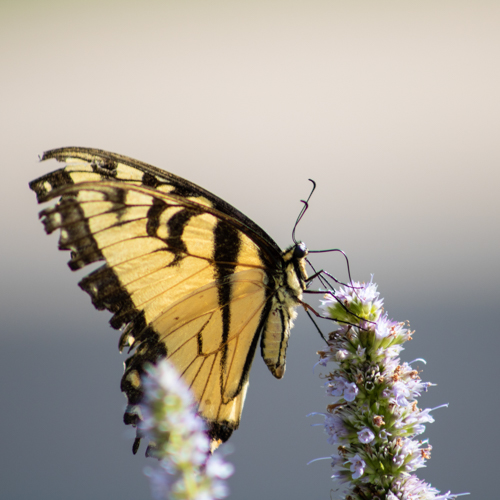
Butterfly sampling purple giant hyssop
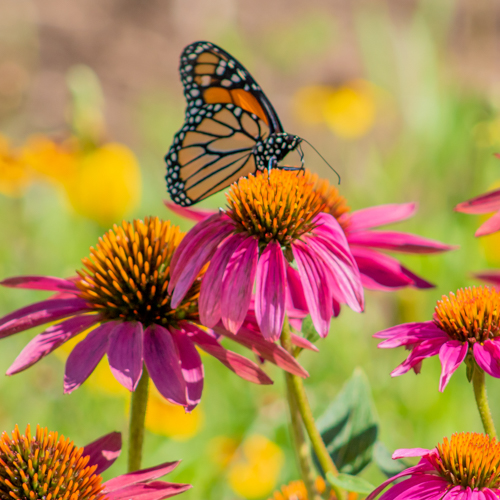
Butterfly sampling purple coneflower
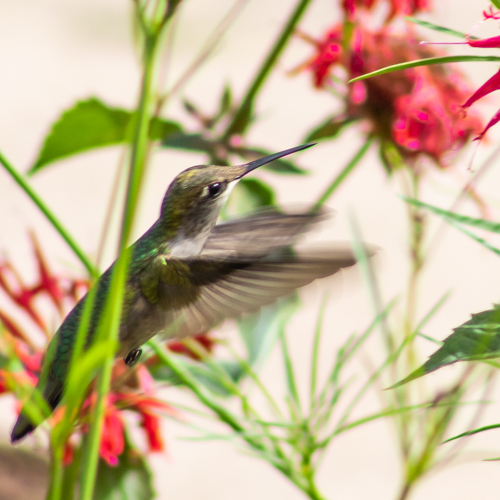
Hummingbird attracted to oswego tea
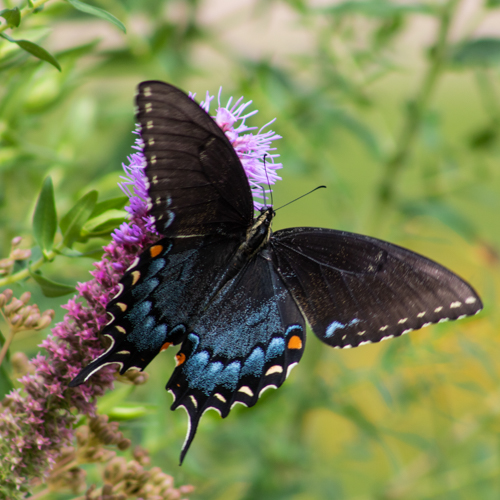
Butterfly on blazing star
Last week, I was surprised to see we had a sweet little feral kitten living in my flowerbeds.The cutest little flower I’ve ever seen!
I was able to trap him and tame him. He gave up the feral life pretty quickly, exchanging flower beds for a comfy bed very quickly. I’m maxed out on cats, personally, but I found a wonderful new forever home for him. I never would have noticed him if I hadn’t been paying so much attention to my flowerbeds.
I even saw a fox two nights ago…so glad the kitten was already rehomed! The wildlife is finding their way into my little personal wildlife refuge—I love it. This is the way it should be.
I do have some non-native plants in my gardens as well, some because I had planted them in previous years and some because I just think they are beautiful, but I try to stick to around 90 percent native plants. Also, I won’t plant anything non-native that will spread and compete with my native plants and crowd them out in any way.
I’ve been busy this summer planning additional beds for next year, using the lasagna method again to kill off grass. I love that native plant gardening forces you to think long-term—there’s no immediate gratification, and that kind of makes it more exciting when it does pay off!
This fall, as the plants go dormant, I will leave them in place, because the birds enjoy picking at the seedheads, and the foliage provides cover and a home for bees and other insects. In the spring, all my “cleanup” will entail will be a quick chopdown of the taller dried plants, leaving the leaf litter in place to reseed the area and add organic material to the soil. So much easier than all the raking, mulching and cleaning up I used to do when I had traditional landscaping in my hard.
I absolutely love the feeling of knowing I am returning my property’s beautiful, sunny, rich Iowa soil to its original state, sort of a very mini prairie restoration, ready to support native plants and pollinators again. I am a 7th generation Iowan, with my earliest family arriving in Iowa in the 1840s. My ancestors were the people who came in and started changing the land to suit their needs…it feels significant that I’m now working to try and restore it, at least the little bit that I’m able to. Sort of a thank you to Iowa’s soil for supporting us and feeding us for so many generations, and a chance to let it breathe and rest again.
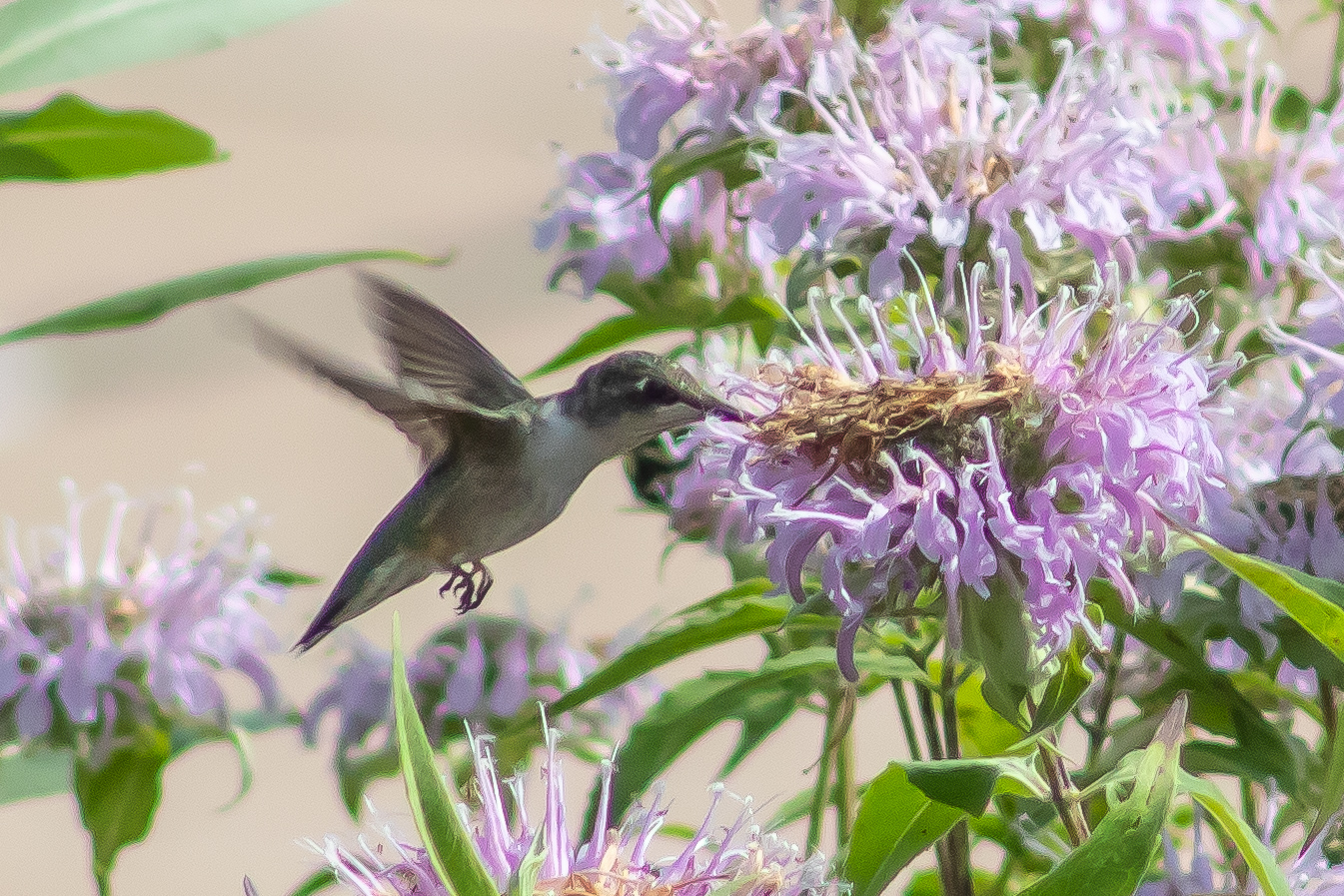
Female or juvenile ruby-throated hummingbird sampling wild bergamot, also known as bee balm or horsemint
You might wonder what my neighbors think. The reaction has been positive! People walking by when I’m working in the yard often tell me how beautiful my flowers are looking. I’m sure it’s not everyone’s cup of tea, but if people don’t like my landscaping choices, they haven’t said anything about it to me. My next-door neighbor commented that he loves my flowers, and really loves the fact he gets to enjoy them without doing any of the work.
I hope people enjoy watching the blossoms, butterflies and birds as they walk by, and also would like to think they feel inspired to perhaps add some native plants to their yards.
Here’s a little before and after from one angle of the yard. What a difference some hard work, a few seeds, and a little time can make:
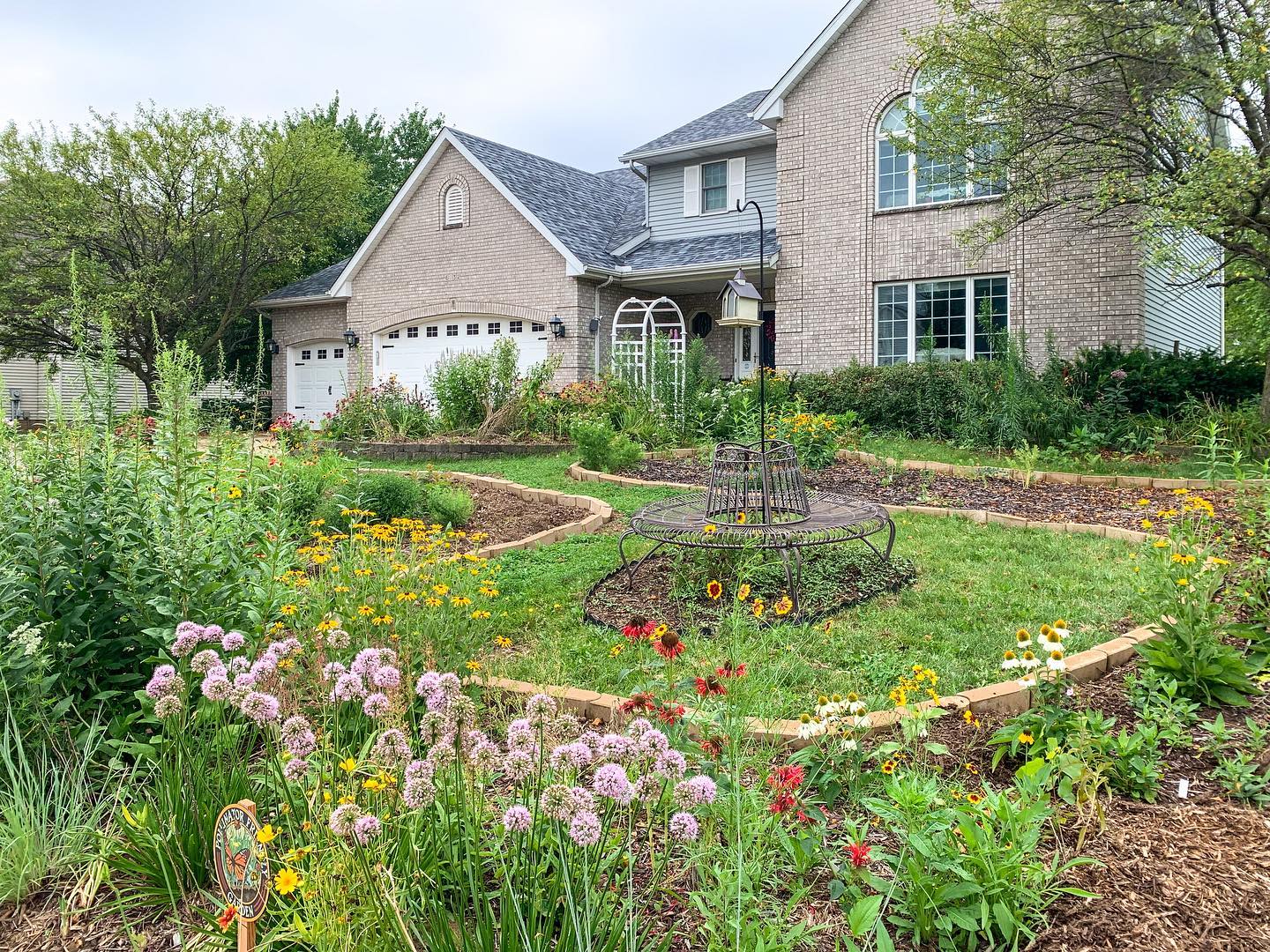
Prairie onion in the foreground, with mix including varieties of purple coneflower and coreopsis
I am documenting my gardening journey on facebook at Casa Leone Gardens and on instagram at Casa Leone Gardens. Feel free to follow along and watch my progress, or maybe get inspired to plant some native plants in your own yard! It’s been an incredibly rewarding process, and such a wonderful distraction to have in these wild times.
Gardening doesn’t have to be drudgery—if you have the right kind of garden, and for me, that’s a native plant garden.


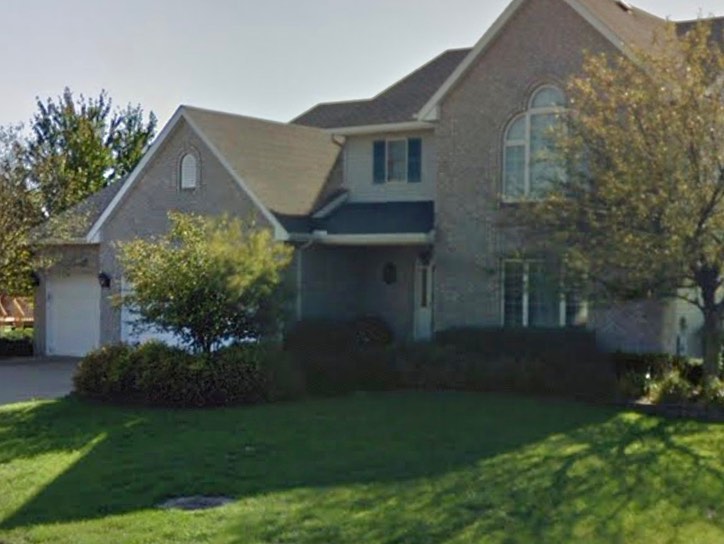
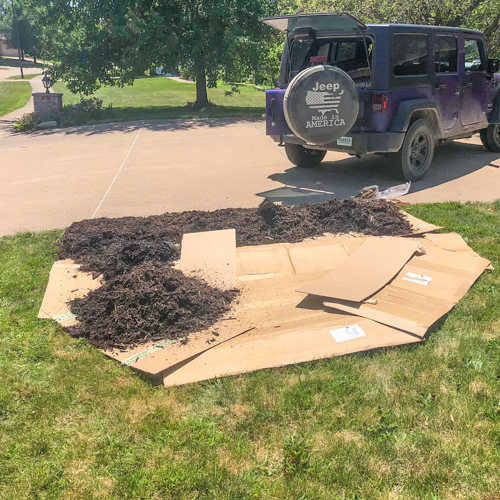
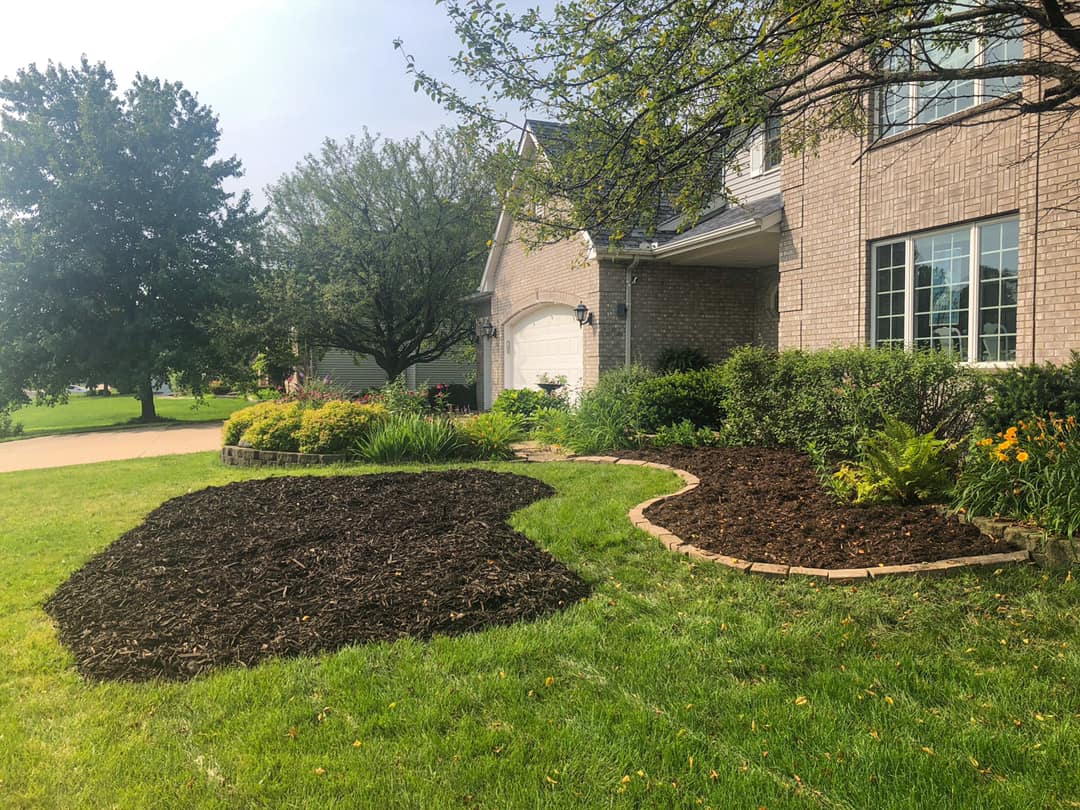
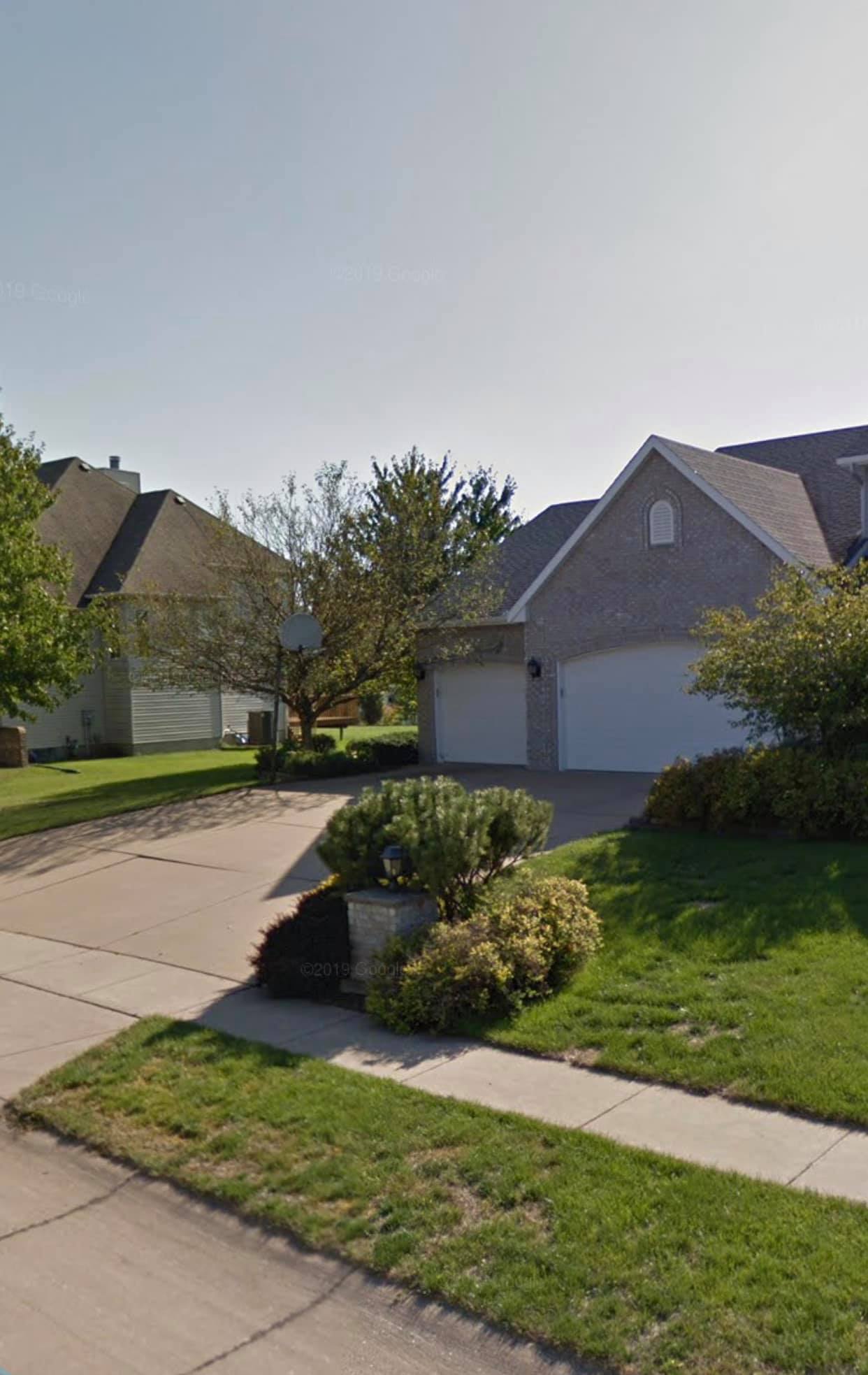
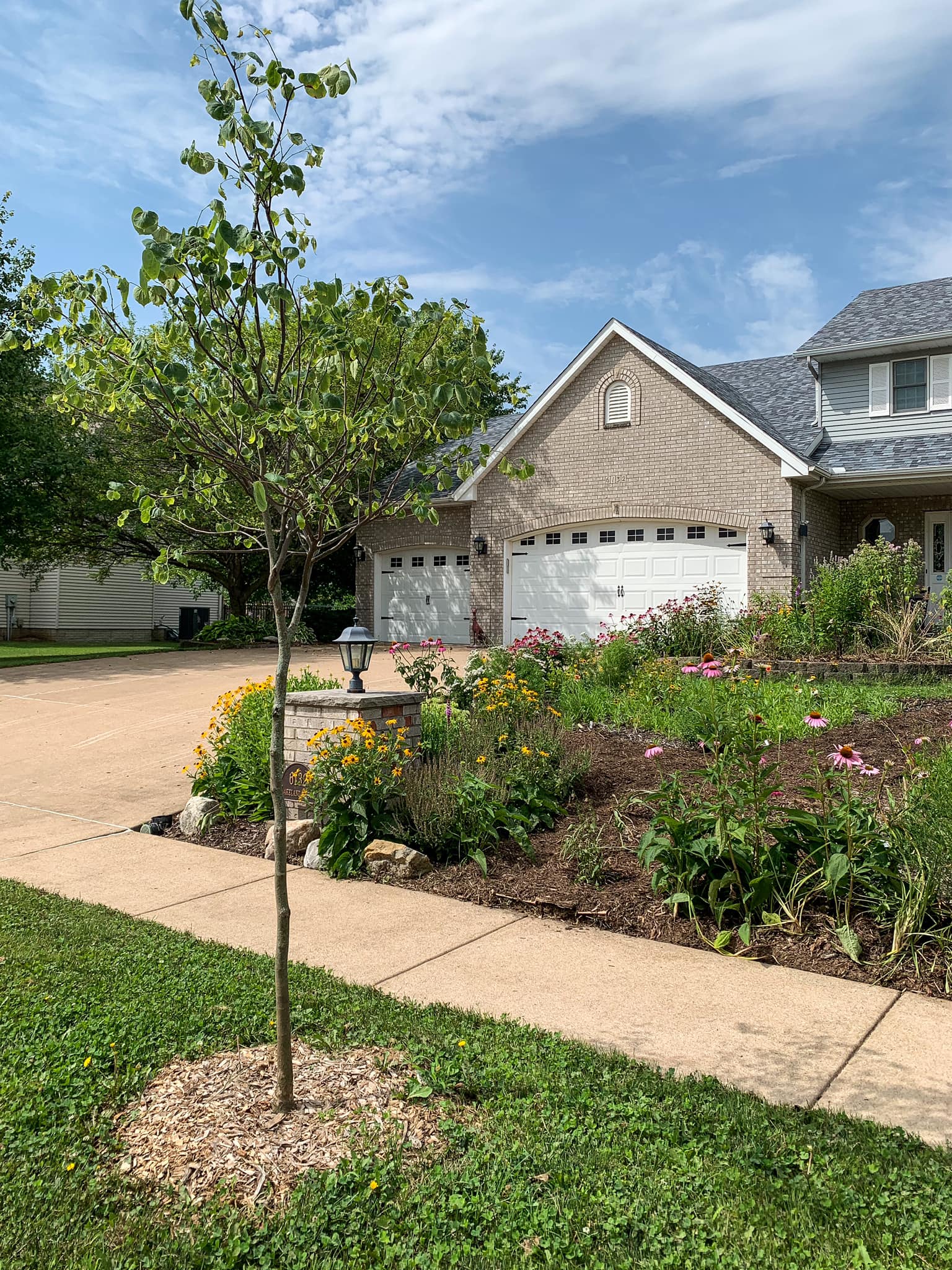
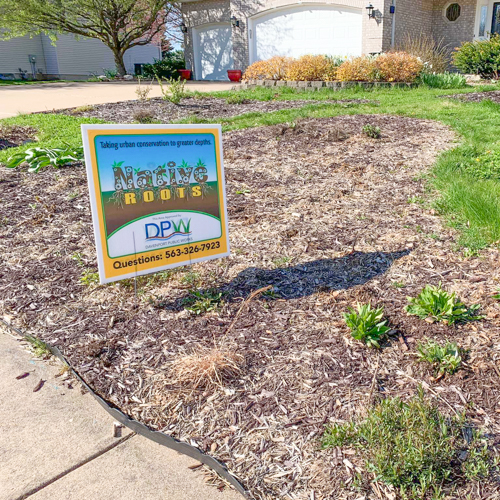
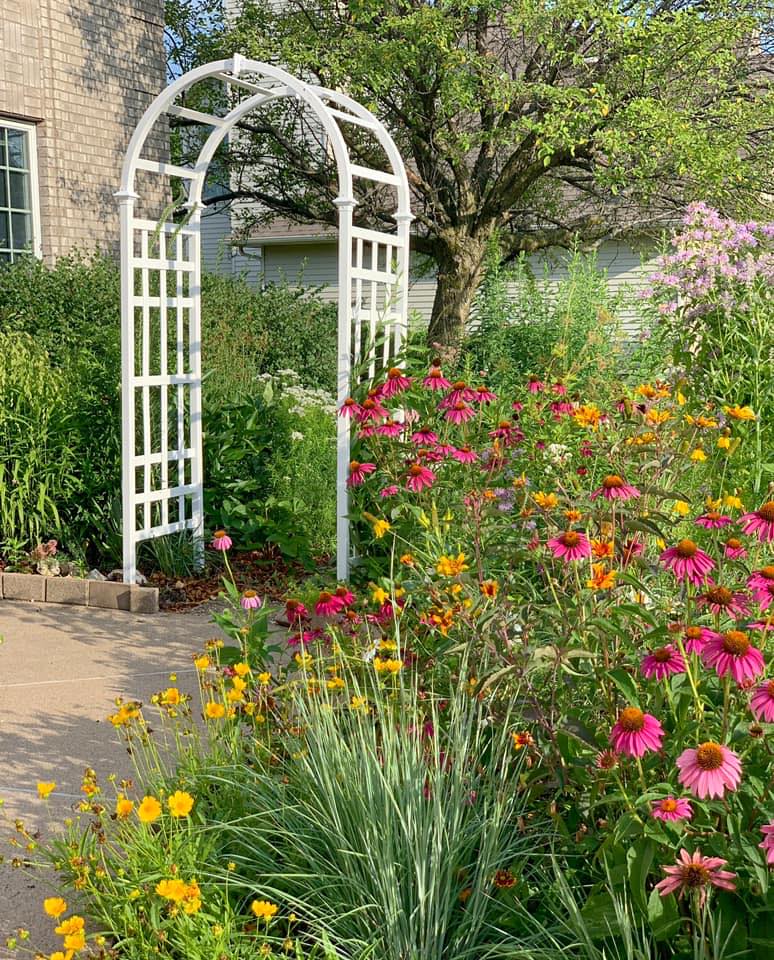
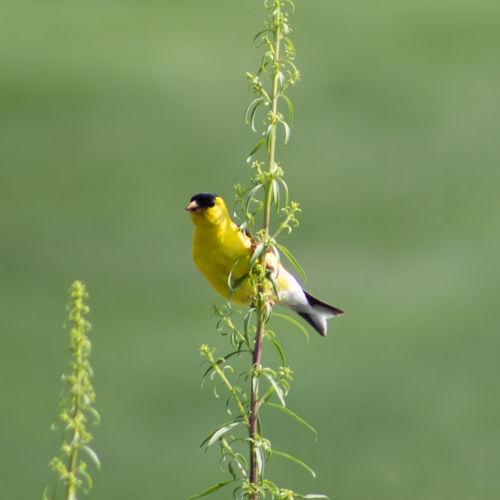
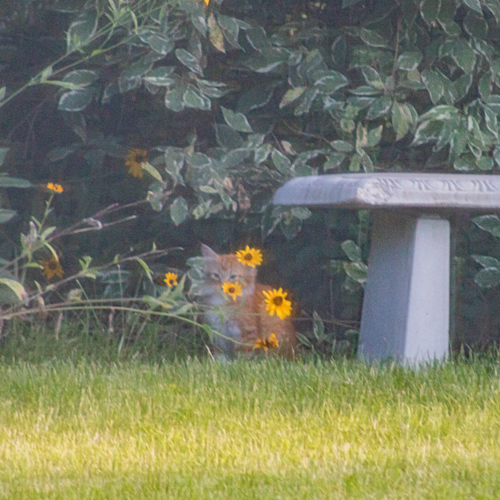
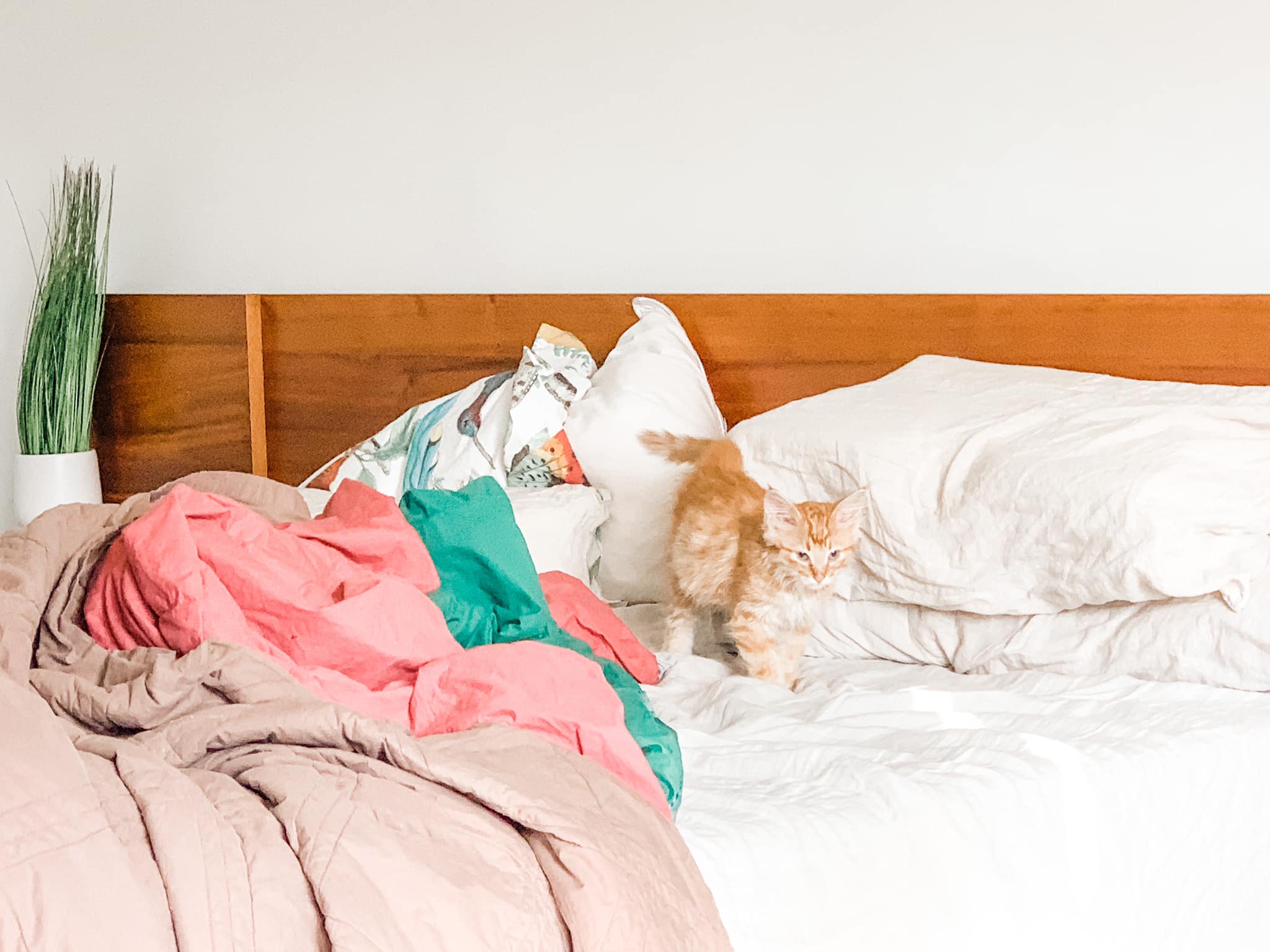
1 Comment
This is so wonderful!!!
Seeing these beautiful photos inspires thoughts of how much better off Iowa would be if almost all yards had at least some of this kind of landscaping. We would live in a much healthier and more magical place. Iowa would also become known in national conservation circles for smart urban landscaping, instead of mostly being known as the most human-altered state in the nation.
And there is so much urban and rural lawn in Iowa that never feels bare human feet and never serves as a place to play ball or lie down and stare at the sky. So many acres of lawn, business and residential, are never used by humans and really do nothing but suck up chemicals and fossil fuels. In spite of lawn industry propaganda, lawns are not good at cleansing air and holding and cleansing stormwater, except when compared to concrete.
I really appreciate the wise recommendation above to look for good native-plant nurseries. Many Iowa garden centers provide little reliable information in regard to native plants.
A few terminology tips for anyone interested. “Wildflower” has no reliable definition, and a “Wildflower Seed Mix” can legally contain just about anything, including Eurasian invasives. That’s why a good native-plant nursery can be so helpful.
“Naturalized” means a non-native species that spreads in the natural landscape. Some Iowa naturalized species, like chicory, are fairly polite, but others, like crown vetch, can be nightmares.
And “native” can be a little tricky. For example, a flower species that is native to the southwestern U.S. might behave invasively when planted hundreds of miles away in the southeastern U.S. And native range limits don’t follow state lines — some flowers are native to eastern Iowa but not western Iowa, northern but not southern Iowa, etc.
All this doesn’t matter if the goal is to plant a beautiful garden that helps pollinators and other wildlife, using plants native to North America. If there is another goal, like planting flowers native to Iowa, or native to eastern Iowa, a little research will need to be done.
I wish many Iowans, especially some local officials, could tour and learn from Casa Leone Gardens. CLG shows how to do urban native-plant landscaping in ways that make neighbors happy and intrigued. We need so much more of that.
PrairieFan Fri 14 Aug 4:08 PM